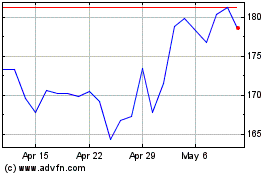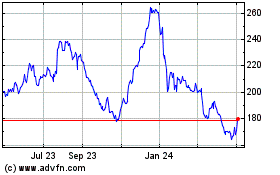By Doug Cameron and Jon Ostrower
Boeing Co. shares fell sharply Thursday as fresh concerns about
the company's accounting method for its jetliners added to investor
anxiety about the outlook for the commercial-aircraft market.
The world's largest aerospace company long has employed a system
called program accounting that averages out expected costs and
revenue on airplane programs over years of production, enabling it
to book anticipated future profits as part of current earnings.
The system is compliant with Generally Accepted Accounting
Principles but rarely used by other companies, and some investors
and shareholders have raised concerns that it builds long-term
assumptions into Boeing's financial reporting about factors that
are too uncertain.
Attention to the accounting method renewed on Thursday after a
report that the Securities and Exchange Commission is investigating
whether Boeing properly accounted for the long-term costs and
expected sales of two of its most prominent jet programs--the 787
Dreamliner and the 747 aircraft. The report, by Bloomberg News,
which cited people with knowledge of the matter, said SEC
enforcement officials hadn't reached conclusions and could decide
against bringing a case.
Boeing and the SEC declined to comment. "We typically do not
comment on media inquiries of this nature," said John Dern, a
Boeing spokesman.
Boeing shares ended down 6.8% in Thursday trading--after
recovering from much steeper declines--to their lowest closing
price since September 2013. The stock is down 25% this year on
concerns that years of record jet deliveries may be petering out
due to strong competition and global economic weakness.
Boeing declined Thursday to comment on its accounting methods.
In the past, Boeing has said that program accounting, which it has
used for decades, is critical to avoiding big swings in earnings
that could make it difficult to pursue projects that can stretch
over years but require huge outlays up front.
Several analysts on Thursday called the stock selloff overblown,
saying that even if Boeing had to change its accounting practices
the likely impact on its cash flow would be small.
However, accounting method aside, if Boeing's cost-saving
projections fall short, then it won't meet cash-generation goals,
eagerly awaited by investors.
Program accounting requires Boeing to estimate cost levels,
sales volumes, and anticipated productivity improvements and
pricing for jets that might be made years in the future. Some
analysts and investors have said that the difficulty of predicting
such long-term factors could make such accounting conclusions
arbitrary.
From the Dreamliner's start, Boeing has had to spend more
producing each of the technologically advanced,fuel-efficient jets
than it gets selling them. Boeing tallies the accumulated shortfall
as "deferred production costs."
For the Dreamliner, that tally grew to $28.5 billion as of the
fourth quarter after delivery of more than 350 of the aircraft
since 2011.
Boeing expects to erase that deficit over time because costs for
making jets generally drop as manufacturers scale up output and
learn to produce more efficiently. The company said last month that
it expects to start making money on a unit basis on each 787
delivery later this year.
Those record costs mean Boeing must average $30.4 million in
profit per plane on its outstanding order backlog, all before it
expects to recover another $8.7 billion on 158 jets it hasn't yet
sold, according to its SEC filings.
Some analysts are concerned that the pace of cost reduction has
fallen short. Boeing's cost-cutting to date is more in line with
its recent jetliner programs, such as its 777, not a more
aggressive decline required to recover its costs, said UBS analyst
David Strauss.
Credit Suisse analyst Rob Spingarn in a December investor note
wrote that Boeing "may be overly optimistic" about its ability to
recover all of its deferred costs, potentially falling short by an
estimated $7.5 billion over its next nearly 1,000 deliveries.
Boeing in 2002 paid $92.5 million to settle a class-action suit
alleging it manipulated program accounting on the 777 jet to shield
the timing of cost overruns and production problems five years
earlier, according to court documents. The company didn't admit
wrongdoing.
Jeff Wilks, director of the School of Accountancy at Brigham
Young University, said program accounting "was trying to recognize
how perverse that reporting would be" if the huge initial costs of
production were reflected in a company's earnings. The risk, he
said, could come if a company "didn't foreshadow or give a good
sense of its expectations" for what it costs and revenues would
be.
Few other companies use program accounting. Rival Airbus
accounts for its jet programs differently, using International
Financial Reporting Standards, booking cost overruns as they occur
rather than trying to amortize them over the life of future
aircraft production.
Airbus took repeated hits to earnings during the development of
the A380 superjumbo as the plane's development and production costs
grew. Airbus last year began delivering the first A380 jets that no
longer lose money.
Boeing has adjusted its expectations for the Dreamliner several
times. It initially set the accounting block--the number of planes
over which it averages costs and revenue--at 1,100 aircraft,
already far larger than it has for earlier programs. It raised that
in 2013 to 1,300 aircraft when it announced plans to boost output,
amounting to about a decade of planned production. Boeing said
those estimates were driven by forecast demand for the jet.
The gap between accounting methods can be sizable. Boeing says
that earnings from operations in its commercial airplanes segment
last year would have been $2.67 billion on a unit-cost accounting
basis, compared with the $5.16 billion it reported using program
accounting.
In 2014, unit accounting would have created a $122 million loss,
compared with the $6.41 billion operating profit Boeing
reported.
Robert Wall and Aruna Viswanatha contributed to this
article.
Write to Doug Cameron at doug.cameron@wsj.com and Jon Ostrower
at jon.ostrower@wsj.com
(END) Dow Jones Newswires
February 11, 2016 19:49 ET (00:49 GMT)
Copyright (c) 2016 Dow Jones & Company, Inc.
Boeing (NYSE:BA)
Historical Stock Chart
From Mar 2024 to Apr 2024

Boeing (NYSE:BA)
Historical Stock Chart
From Apr 2023 to Apr 2024
